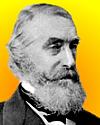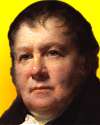 | TODAY IN SCIENCE HISTORY
NEWSLETTER - 10 MARCH |
 On 10 Mar 1668, Johann Glauber died, but is remembered in the compound still known as Glauber's salt. As a chemist, he made contributions of value, but at other times, he showed the age in which he lived still retained aspects of alchemy. For example, to understand his writing: “First a man is to be made of iron, having two noses on his head, and on his crown a mouth which may be opened and again close shut...” you need to know he is describing an apparatus. On 10 Mar 1668, Johann Glauber died, but is remembered in the compound still known as Glauber's salt. As a chemist, he made contributions of value, but at other times, he showed the age in which he lived still retained aspects of alchemy. For example, to understand his writing: “First a man is to be made of iron, having two noses on his head, and on his crown a mouth which may be opened and again close shut...” you need to know he is describing an apparatus.
To see a diagram of this apparatus, and learn about his legacy as a mix of his valid work in chemistry and absurd alchemical thinking, read this extract from a chapter, “Period of Medical Mysticism” from A Science-History of the Universe (1909) for a short biography of Johann Glauber.
|
 On 10 Mar 1628, Marcello Malpighi was born, a leading early modern anatomist with wide and varied interests. Today's Science Store pick is Mechanism, Experiment, Disease: Marcello Malpighi and Seventeenth-Century Anatomy, by Domenico Bertoloni Meli (published Apr 2011), who provides an understanding of how in the 17th century scholars and ideas crossed disciplinary boundaries. He examines Malpighi's work within this context, describing how anatomical knowledge was achieved and transmitted and how those processes interacted with the experimental and mechanical philosophies, natural history, and medical practice. New: $ On 10 Mar 1628, Marcello Malpighi was born, a leading early modern anatomist with wide and varied interests. Today's Science Store pick is Mechanism, Experiment, Disease: Marcello Malpighi and Seventeenth-Century Anatomy, by Domenico Bertoloni Meli (published Apr 2011), who provides an understanding of how in the 17th century scholars and ideas crossed disciplinary boundaries. He examines Malpighi's work within this context, describing how anatomical knowledge was achieved and transmitted and how those processes interacted with the experimental and mechanical philosophies, natural history, and medical practice. New: $45.00. Save 10% Price $40.46. (as of time of writing). Yesterday's pick: The Speckled Monster: A Historical Tale of Battling the Smallpox Epidemic, by Jennifer Lee Carrell.
For picks from earlier newsletters, see the Today in Science Science Store home page. | |

| "The leading idea which is present in all our [geological] researches, and which accompanies every fresh observation, the sound of which to the ear of the student of Nature seems echoed from every part of her works, is—Time!—Time!—Time!"
- George Julius Poulett Scrope, English geologist. (born 10 Mar 1797)  |
 | "Amid all the revolutions of the globe, the economy of Nature has been uniform, ... and her laws are the only things that have resisted the general movement. The rivers and the rocks, the seas and the continents, have been changed in all their parts; but the laws which direct those changes, and the rules to which they are subject, have remained invariably the same." - John Playfair, English mathematician. (born 10 Mar 1748)  |

| "For Nature is accustomed to rehearse with certain large, perhaps baser, and all classes of wild (animals), and to place in the imperfect the rudiments of the perfect animals."
- Marcello Malpighi, Italian physician and biologist. (born 10 Mar 1628)  |
| Before you look at today's web page, see if you can answer some of these questions about the events that happened on this day. Some of the names are very familiar. Others will likely stump you. Tickle your curiosity with these questions, then check your answers on today's web page. |
 |  George Julius Poulett Scrope, born 10 Mar 1797, was an English geologist and political economist whose volcanic studies helped depose the theory that all the world's rocks were formed by sedimentation from the oceans (During the first half of the nineteenth century, the belief in a universal deluge was widely held by geologists.) George Julius Poulett Scrope, born 10 Mar 1797, was an English geologist and political economist whose volcanic studies helped depose the theory that all the world's rocks were formed by sedimentation from the oceans (During the first half of the nineteenth century, the belief in a universal deluge was widely held by geologists.)  By what name was the earlier (all-sedimentation rocks) theory known? By what name was the earlier (all-sedimentation rocks) theory known?  |
 |  Jeremias B. Richter, born 10 Mar 1762, was a chemist who discovered the law of equivalent proportions. He looked for mathematical relationships in chemisty, convinced that substances reacted with each other in fixed proportions. He showed such a relationship when acids and bases neutralize to produce salts (1791). Jeremias B. Richter, born 10 Mar 1762, was a chemist who discovered the law of equivalent proportions. He looked for mathematical relationships in chemisty, convinced that substances reacted with each other in fixed proportions. He showed such a relationship when acids and bases neutralize to produce salts (1791).  What was his nationality? What was his nationality? |
 |  Johann Rudolf Glauber (1604-1668) was a German-Dutch chemist, sometimes called the German Boyle; i.e., the German father of chemistry. Glauber supported himself by selling secret chemicals and medicinals. He prepared hydrochloric acid from common salt and sulfuric acid. He also noted the formation of nitric acid from potassium nitrate and sulfuric acid. He pointed out the virtues of sal mirabile, also known as Glauber's salt. Johann Rudolf Glauber (1604-1668) was a German-Dutch chemist, sometimes called the German Boyle; i.e., the German father of chemistry. Glauber supported himself by selling secret chemicals and medicinals. He prepared hydrochloric acid from common salt and sulfuric acid. He also noted the formation of nitric acid from potassium nitrate and sulfuric acid. He pointed out the virtues of sal mirabile, also known as Glauber's salt.
 What is the chemical name of Glauber's salt? What is the chemical name of Glauber's salt? |
 |  On 10 Mar of a certain year, Herbert H. Hoover became the first civilian pilot to exceed the speed of sound when he flew a Bell X-1 research aircraft at Edwards AFB, California. Instead of making its own take-off, the X-1 was loaded under the bomb bay of a B29 mother ship which carried it aloft, then released it at 20,000 feet. He reached Mach 1.065. On 10 Mar of a certain year, Herbert H. Hoover became the first civilian pilot to exceed the speed of sound when he flew a Bell X-1 research aircraft at Edwards AFB, California. Instead of making its own take-off, the X-1 was loaded under the bomb bay of a B29 mother ship which carried it aloft, then released it at 20,000 feet. He reached Mach 1.065.  In what decade was this supersonic civilian flight made? In what decade was this supersonic civilian flight made? |

|  On 10 Mar 1891, a U.S. patent was issued to Almon B. Strowger for his electromechanical switch. His selector used electromagnets and pawls to move a wiper (with contacts on the end) vertically and around a bank of many other contacts, able to make a connection with any one of them. On 10 Mar 1891, a U.S. patent was issued to Almon B. Strowger for his electromechanical switch. His selector used electromagnets and pawls to move a wiper (with contacts on the end) vertically and around a bank of many other contacts, able to make a connection with any one of them.  What was the purpose of his invention? What was the purpose of his invention? |
When you have your answers ready to all the questions above, you'll find all the information to check them, and more, on the March 10 web page of Today in Science History. Or, try this link first for just the brief answers.
Fast answers for the previous newsletter for March 9: Yury Gagarin; carborundum; Danish; the decade including the year 1948; mail collection box. |
 If you enjoy this newsletter, the website, or wish to offer encouragement or ideas, please send feedback by using your mail reader Reply button. If you enjoy this newsletter, the website, or wish to offer encouragement or ideas, please send feedback by using your mail reader Reply button. |
--
If you do not want to receive any more newsletters,
Unsubscribe To update your preferences and to unsubscribe visit
this link 


 On 10 Mar 1668, Johann Glauber died, but is remembered in the compound still known as Glauber's salt. As a chemist, he made contributions of value, but at other times, he showed the age in which he lived still retained aspects of alchemy. For example, to understand his writing: “First a man is to be made of iron, having two noses on his head, and on his crown a mouth which may be opened and again close shut...” you need to know he is describing an apparatus.
On 10 Mar 1668, Johann Glauber died, but is remembered in the compound still known as Glauber's salt. As a chemist, he made contributions of value, but at other times, he showed the age in which he lived still retained aspects of alchemy. For example, to understand his writing: “First a man is to be made of iron, having two noses on his head, and on his crown a mouth which may be opened and again close shut...” you need to know he is describing an apparatus. 



 George Julius Poulett Scrope, born 10 Mar 1797, was an English geologist and political economist whose volcanic studies helped depose the theory that all the world's rocks were formed by sedimentation from the oceans (During the first half of the nineteenth century, the belief in a universal deluge was widely held by geologists.)
George Julius Poulett Scrope, born 10 Mar 1797, was an English geologist and political economist whose volcanic studies helped depose the theory that all the world's rocks were formed by sedimentation from the oceans (During the first half of the nineteenth century, the belief in a universal deluge was widely held by geologists.) 
 Jeremias B. Richter, born 10 Mar 1762, was a chemist who discovered the law of equivalent proportions. He looked for mathematical relationships in chemisty, convinced that substances reacted with each other in fixed proportions. He showed such a relationship when acids and bases neutralize to produce salts (1791).
Jeremias B. Richter, born 10 Mar 1762, was a chemist who discovered the law of equivalent proportions. He looked for mathematical relationships in chemisty, convinced that substances reacted with each other in fixed proportions. He showed such a relationship when acids and bases neutralize to produce salts (1791).  What was his nationality?
What was his nationality? 
 Johann Rudolf Glauber (1604-1668) was a German-Dutch chemist, sometimes called the German Boyle; i.e., the German father of chemistry. Glauber supported himself by selling secret chemicals and medicinals. He prepared hydrochloric acid from common salt and sulfuric acid. He also noted the formation of nitric acid from potassium nitrate and sulfuric acid. He pointed out the virtues of sal mirabile, also known as Glauber's salt.
Johann Rudolf Glauber (1604-1668) was a German-Dutch chemist, sometimes called the German Boyle; i.e., the German father of chemistry. Glauber supported himself by selling secret chemicals and medicinals. He prepared hydrochloric acid from common salt and sulfuric acid. He also noted the formation of nitric acid from potassium nitrate and sulfuric acid. He pointed out the virtues of sal mirabile, also known as Glauber's salt.  What is the chemical name of Glauber's salt?
What is the chemical name of Glauber's salt? 
 On 10 Mar of a certain year, Herbert H. Hoover became the first civilian pilot to exceed the speed of sound when he flew a Bell X-1 research aircraft at Edwards AFB, California. Instead of making its own take-off, the X-1 was loaded under the bomb bay of a B29 mother ship which carried it aloft, then released it at 20,000 feet. He reached Mach 1.065.
On 10 Mar of a certain year, Herbert H. Hoover became the first civilian pilot to exceed the speed of sound when he flew a Bell X-1 research aircraft at Edwards AFB, California. Instead of making its own take-off, the X-1 was loaded under the bomb bay of a B29 mother ship which carried it aloft, then released it at 20,000 feet. He reached Mach 1.065.  In what decade was this supersonic civilian flight made?
In what decade was this supersonic civilian flight made? 
 On 10 Mar 1891, a U.S. patent was issued to Almon B. Strowger for his electromechanical switch. His selector used electromagnets and pawls to move a wiper (with contacts on the end) vertically and around a bank of many other contacts, able to make a connection with any one of them.
On 10 Mar 1891, a U.S. patent was issued to Almon B. Strowger for his electromechanical switch. His selector used electromagnets and pawls to move a wiper (with contacts on the end) vertically and around a bank of many other contacts, able to make a connection with any one of them.  What was the purpose of his invention?
What was the purpose of his invention?  If you enjoy this newsletter, the website, or wish to offer encouragement or ideas, please send feedback by using your mail reader Reply button.
If you enjoy this newsletter, the website, or wish to offer encouragement or ideas, please send feedback by using your mail reader Reply button. 

Δεν υπάρχουν σχόλια:
Δημοσίευση σχολίου